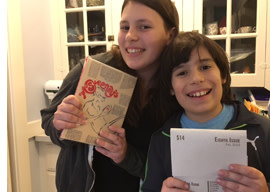
I work at Continuum, but I come at innovation from the English department. From the arts-and-literature section of the paper. The literary quarterly. The 800 section of the library. Until I started this gig, on January 12, 2015, the innovations that most occupied my mind were books, paragraphs, sentences of the greatest and most lasting originality. I am an unmistakably old-fashioned being: the book nerd.
So when I hear the word “innovation,” my mind easily flips from the category creating Swiffer to Milan Kundera on art’s obligation to say the never-before-said, from the unprecedented iluminage Skin Smoothing Laser to Harold Bloom’s foggy theories of the anxiety of influence. And while I’m not going to bore you with a lecture on why product design figures so centrally in the work of Nicholson Baker—and it does!—I do think there’s something literature can teach innovation and design, and that is this: It’s smart to take a larger perspective on generations.
At my place of business, we can’t stop talkin’ bout generations, particularly Y and Z and, once in a chartreuse moon, even those gens that precede and follow the tail-end of the alphabet (Where do we go after Z?).
So why are generations a hot topic? The market suggests that there’s a particular element of socialization that creates expectations and demands in products and services, in people born in a particular time and place. To take the most obvious point: in 2015, millennials earn less than baby boomers, and have much more debt, and thus it makes sense to consider each when creating products that might be of interest to each. Of course, it’s more than just money; much of generational issues have to do with cultural misunderstandings.
And yet, one can sometimes wonder if this kind of differentiation, the insistence of seeing such rigid, age-based niches, is a means of limiting us, and our clients. (Note: As a 45 year-old, I recall when the media couldn’t shut up about Generation X. Now I’m thankful that the youngsters have usurped the spotlight.) It is the underlying assumption of so much business thinking that disruption is inevitable and that long-term sustainability is a façade. In some ways, this is an extension of the limitations of generational thinking. Literature, on the other hand, aims at endurance. Paul Eluard called it le dur désir de durer, which critic George Steiner renders as “the harsh contrivance of spirit against death, the hope to overreach time by force of creation.” For the literary artist, it is as Aristotle nicely defines it: “The excellent becomes the permanent.”
The limitations of short-term ambition is sketched out by the peerless Cynthia Ozick. Sayeth Ozick:
"The problem with believing in generations is not only the most obvious one—that you excise history, that you cut off even the most immediately usable past—but the sense of narrow obligation it imposes on the young, a kind of prisoner’s outlook no less burdensome than all the following dicta taken together:
- That each new crop of mass births must reinvent culture.
- That models are unthinkable.
- That each succeeding generation is inherently brighter and more courageous than the one before.
- That ‘establishments’ are inherently closed.
- That whatever has won success is by definition stale."
Ozick goes on to list several other dicta which are too literary for our concern—but that’s no matter. The central theme is this: We should be wary of focusing too much energy on the young and ignoring everyone else. The smarter innovator works to move universal humanity. Why? Because it’s a plan for long-term sustainable success. If your organization is only focused on the current generation, or the one on the way up… you’re needlessly narrowing your horizon. Or to put it another way, you’re assuming your own eventual irrelevancy by failing to think of the far-away future.
“There is no predicament that cures itself so swiftly as belonging to ‘the young,’” Ozick continues. “Alice, nibbling at the mushroom, shrank so quickly that her chin crashed into her shoe: that fast is how we go from twenty-three to fifty-four, and from fifty-five to sixty-eight. Vita brevis!”
Point is, for those of us in business, no matter what our literary predilections: Yes, there are needs unique to any group (ethnic, gender, or age) but also some enduring qualities of people that should be remembered.
The literary perspective is to think, with T.S. Eliot, of the idea of continuity by adding your contribution while you live. Yes, you work with the materials at hand and interact with the living audience… but the longer aspiration is what really matters. Innovators should be thinking this way. Designers too. This is what Dieter Rams is all about when he turns to the subject of sustainability and design.
It is in understanding that we must innovate for a particular group of people in a particular time, and that we can’t be so shortsighted as to only think of the contemporary, that led Hemingway to offer two opposing epigraphs in The Sun Also Rises:
"You are all a lost generation.
—Gertrude Stein in conversation
One generation passeth away, and another generation cometh; but the earth abideth forever… The sun also ariseth, and the sun goeth down, and hasteth to the place where he arose… The wind goeth toward the south, and turneth about unto the north; it whirleth about continually, and the wind returneth again according to its circuits… All the rivers run into the sea; yet the sea is not full; unto the place from whence the rivers come thither they return again.
—Ecclesiastes"




